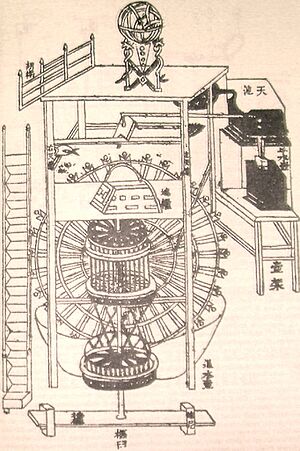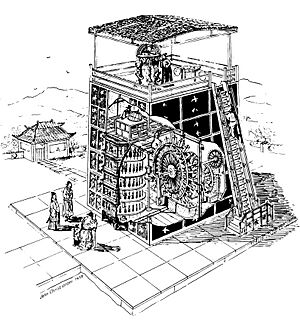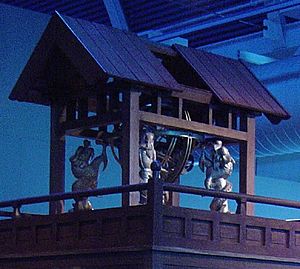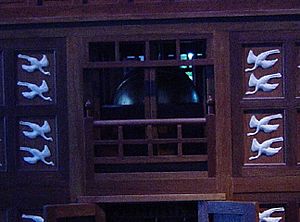Su Song facts for kids
Quick facts for kids
Su Song
|
|
|---|---|
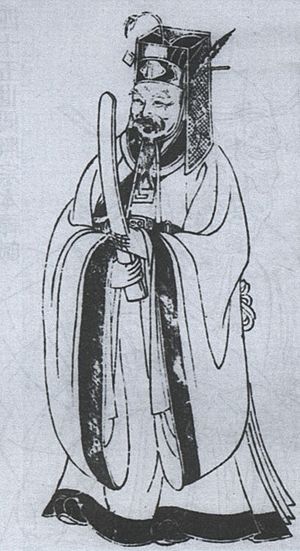 |
|
| Born | 1020 near Quanzhou city
|
| Died | 1101 (aged 80–81) |
| Occupation | Scholar-bureaucrat
|
| Su Song | |||||||||||||
|---|---|---|---|---|---|---|---|---|---|---|---|---|---|
| Chinese | 蘇頌 | ||||||||||||
|
|||||||||||||
Su Song (Chinese: 蘇頌, 1020–1101) was a super smart Chinese scientist and government official. He was good at many things, like mathematics, astronomy, making maps, geography, clocks, medicine, and machines. He lived during the Song dynasty (960–1279).
Su Song designed a huge astronomical clock tower in the city of Kaifeng. This clock tower used water power and had a special part called an escapement mechanism. This mechanism helped the clock keep time accurately. Su Song's clock tower also had the oldest known chain drive system, which he called the "celestial ladder." This chain helped power the clock. The tower had 133 small figures that would come out to tell the time by ringing bells or beating drums.
Su Song wrote a book about his clock tower called Xinyi Xiangfayao in 1092. This book has helped many historians understand his amazing invention. Sadly, the clock tower was taken apart by an invading army in 1127. Even though people tried to put it back together, it never worked again.
Besides the clock tower, Su Song also made a big celestial atlas with star maps and maps of the Earth. He also wrote a book about medicine, which included information on minerals, animals, plants, and metals.
Some European visitors to China later thought that the Chinese only had simple clocks like water clocks or sundials. They didn't realize how advanced Chinese mechanical clocks, like Su Song's, actually were. Even though Su Song's clock tower used a waterwheel for power, it was still a very complex machine for its time.
Contents
Su Song's Life and Amazing Work
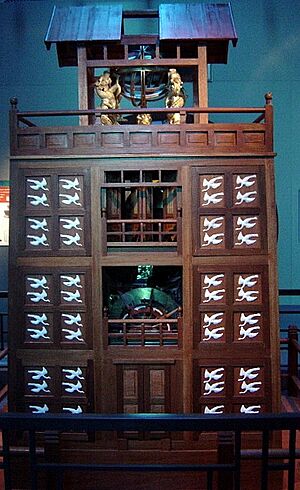
Becoming a Scholar and Official
Su Song was born in what is now Fujian, near the city of Quanzhou. Like another smart person of his time, Shen Kuo, Su Song was a polymath. This means he was an expert in many different subjects. When he was young, he did very well on the important government exams. He even wrote the best essay about the Chinese calendar. His interest in stars and calendars helped him become a respected government official. In his free time, he enjoyed writing poems and collecting old artworks.
In the government, Su Song became an Ambassador and even the head of the Ministry of Personnel in Kaifeng. He was known for being good at managing things and handling money. Later, he became the Minister of Justice. He also helped edit an important old book called Huainanzi. Eventually, Su Song became a very high-ranking official, serving as the Vice President of the Chancellery Secretariat. He tried to stay out of the fights between different political groups at court.
In 1077, he went on a diplomatic trip to the Liao dynasty in the north. He shared ideas about calendars with them. Su Song found out that the Liao calendar was actually more accurate than China's own calendar. This made some officials in China's Bureau of Astronomy get into trouble! Su Song's knowledge of map-making also helped solve a border dispute between the Song and Liao dynasties.
Exploring the Stars: Astronomy
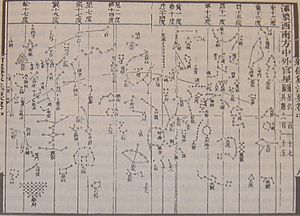
Su Song created a celestial atlas with five different star maps. These maps showed the positions of stars and how they moved. He used a special way to draw them, making sure they were accurate. Su Song also used discoveries made by his rival, Shen Kuo. For example, Su Song's fourth star map showed the pole star in a more accurate position, which Shen Kuo had figured out earlier. Su Song's star maps are the oldest printed star maps that we still have today.
Understanding Nature: Medicine, Plants, Animals, and Minerals

In 1070, Su Song and other scholars put together a huge book called Bencao Tujing (Illustrated Pharmacopoeia). This book was a big step forward in understanding medicine, plants, animals, and minerals.
This book had lots of information about how to use different things for medicine. It also included details about the metal and iron industries in 11th-century China. Su Song listed various minerals and how they could be used as medicine. For example, he described different types of mica that people thought could cure illnesses. He also wrote about how minerals like cinnabar looked and where they could be found. Su's book was the first in China to describe plants like flax. He accurately described realgar, a mineral, noting its deep red color and how it came from rocky river areas.
Su Song also described animals and where they lived. For instance, he noted that the Chinese mitten crab could be found in the Huai River and other waterways. Su's important book was later copied and saved in another famous medical book called Bencao Gangmu.
Amazing Machines: Clocks and Engineering
Su Song wrote one of the most important books about clocks from the Middle Ages. He worked with many engineers and astronomers on his projects. His book, Xinyi Xiangfayao, finished in 1092, showed all his amazing work on clocks and machines. It had 47 detailed drawings of his clock tower.
Su Song's biggest project was the 40-foot-tall water-powered astronomical clock tower in Kaifeng. He first made a small wooden model in 1088. The bronze parts were ready by 1090, and the whole tower was finished in 1094. The emperor himself asked Su Song to build this new clock tower. Su Song worked with Han Gong-lian, who helped with the math.
The clock tower had many cool features:
- A huge, rotating armillary sphere on top, weighing 10 to 20 tons.
- A bronze celestial globe inside, 4.5 feet wide.
- Moving figures dressed in Chinese clothes that came out of small doors to announce the time. They would show plaques, ring bells, or beat drums.
- Clever gears and an escapement mechanism.
- It looked like a fancy Chinese pagoda.
The tower was called the Shui Yun Yi Xiang Tai, meaning "Tower for the Water-Powered Sphere and Globe."
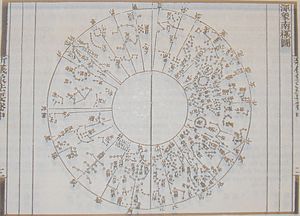
Years after Su Song died, the city of Kaifeng was attacked in 1127. The invading army took the clock tower apart and moved its pieces to their own capital. But it was so complex that they couldn't put it back together. The new emperor asked Su Song's son, Su Xie, to build another one. Su Xie tried, but he couldn't do it either. He thought his father might have left out some important details on purpose, so no one could steal his ideas.
Su Song's clock was mainly for the government's astronomers and astrologers. It didn't lead to many clocks being made for everyone. However, the idea of mechanical clocks continued in China. Later, in the Yuan dynasty, the astronomer Guo Shoujing helped restore an observatory and built a water-powered armillary sphere with clock figures. Even in the Ming dynasty, new clock designs appeared, some using falling sand instead of water for power.
How Su Song's Clock Worked
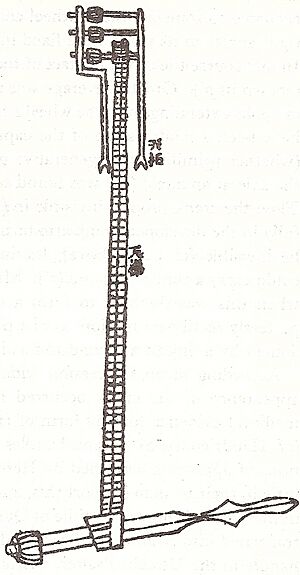
Su Song's clock combined an old water clock idea with new mechanical parts. Water flowed into small containers, and their weight would make the clock's parts move. This was how the escapement mechanism worked, stopping and releasing the movement at regular times.
Su Song gave credit to earlier Chinese scientists like Zhang Heng for their water-powered armillary spheres. He was also inspired by Zhang Sixun's armillary sphere from 976 AD, which used liquid mercury instead of water. Mercury wouldn't freeze in winter and wouldn't rust the metal parts. But Su Song noted that after Zhang Sixun died, no one could rebuild his device, just like his own.
The main part of Su Song's clock tower was a huge driving-wheel, 11 feet wide, with 36 scoops. Water poured into these scoops at a steady rate. This wheel turned a main iron shaft, which then connected to other gears to power the clock.
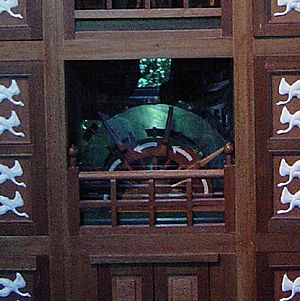
Su Song's book had detailed drawings of how the escapement mechanism worked. It showed all the different parts like locks, levers, and counterweights working together.
The Endless Chain Drive
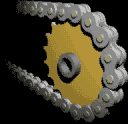
Su Song's book has the oldest picture of an endless chain drive that moves power. This chain was used in the clock tower to connect the main driving shaft to the armillary sphere. It was called the "celestial ladder." Even though ancient Greeks had a type of endless belt, Su Song's chain drive was likely inspired by the chain pumps used in China since the Han dynasty.
Su Song wrote about the chain drive:
The chain drive (called the celestial ladder) is about 19.5 ft long (5.9 m). It works like this: an iron chain, with its links joined together, hangs from an upper wheel and also goes around a lower wheel on the main driving-shaft. When one link moves, it turns a tooth on a gear, which then moves the parts that tell time, following the movement of the heavens.
The gears had 600 teeth. Su Song carefully calculated this to divide the day into very small measurements of 2 minutes and 24 seconds each.
Su Song's Armillary Sphere
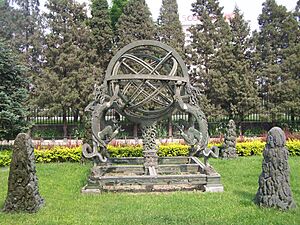
Su Song's armillary sphere had three layers of rings that rotated mechanically. An earlier Chinese astronomer, Li Chun-feng, had created the first three-layered armillary sphere in 633 AD. Su Song's design was very advanced for its time.
His armillary sphere had several parts:
- The Outer Layer:
- Meridian circle
- Horizon circle
- Outer equator circle
- The Middle Layer:
- Solstitial colure circle (shows sun's path)
- Ecliptic circle (shows sun's yearly path)
- Diurnal motion gear-ring (connects to power)
- The Inner Layer:
- Polar-mounted declination ring (shows star positions)
- Sighting tube (for looking at stars)
- Other Parts:
- Vertical column (hides the shaft)
- Dragon-shaped supporting columns
- Base with water-levels
- North and south polar pivots
Su Song's Legacy
Su Song's book Xinyi Xiangfayao was published and widely printed in China. This helped spread his ideas. When he showed his clock tower design to the emperor, Su Song said that the steady flow of water was like the constant movement of the heavens. This made the emperor happy, as it showed his power.
Later scholars also copied and reprinted Su Song's work, making sure to keep it exactly as he wrote it. Although other books on astronomical clocks were written in China, Su Song's is one of the few that still exists today.
In modern times, the British historian Joseph Needham studied Su Song's texts and achievements in his famous book series Science and Civilization in China. In the 1950s, people like John Christiansen and John Cambridge built models of Su Song's clock tower. In China, Wang Zhenduo also built a smaller model for the Chinese Historical Museum in Beijing. These models help us understand how amazing Su Song's inventions were.
See also
 In Spanish: Su Song para niños
In Spanish: Su Song para niños
- Zhang Heng, an early Chinese inventor of a water-powered armillary sphere
- Clock tower
- Technology of the Song dynasty
- Water clock
- Chinese inventions and discoveries


